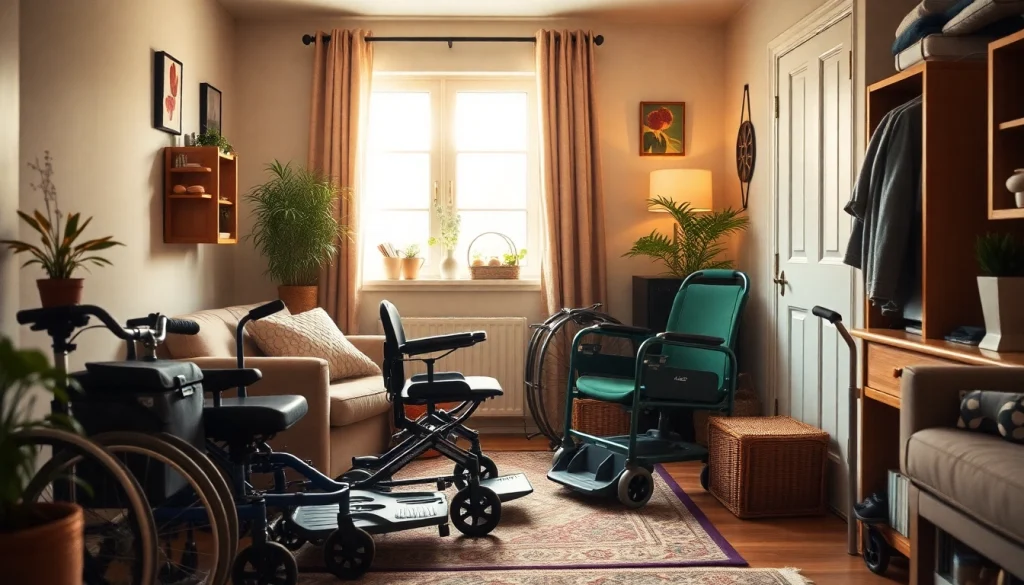
Understanding Mobility Equipment
What is Mobility Equipment?
Mobility equipment encompasses a wide range of devices designed to assist individuals with mobility challenges in achieving greater independence and improved quality of life. This equipment can aid a variety of users, including seniors, individuals with disabilities, or those recovering from surgery. It includes devices such as wheelchairs, walkers, scooters, and more specialized tools to facilitate movement and access in daily living.
The primary goal of mobility equipment is to enhance mobility and accessibility, allowing users to navigate their environments more easily. For individuals who face challenges in moving from one place to another, the right equipment can be transformative, not just physically but emotionally and socially as well. When discussing mobility equipment, it is important to recognize its effective role in empowering users.
Common Types of Mobility Equipment
There are several types of mobility equipment that cater to different needs and preferences:
- Wheelchairs: Available in manual and electric versions, wheelchairs are among the most recognized mobility aids, suitable for users who have difficulty walking.
- Walkers: Walkers provide support for standing and walking, making them ideal for individuals who require a stable, supportive aid when moving.
- Rollators: These are walkers equipped with wheels, giving users more mobility. Most rollators also come with brakes and a seat, allowing for rest when needed.
- Power Scooters: Scooters are ideal for individuals looking for a convenient way to navigate larger spaces without the physical effort of walking or pushing a wheelchair.
- Lift Chairs: These specially designed chairs help individuals stand up from a seated position safely and comfortably.
- Canes and Crutches: These assistive devices provide balance and stability for individuals with mild to moderate mobility challenges.
Benefits of Using Mobility Equipment
The benefits of utilizing mobility equipment are extensive and impactful:
- Increased Independence: Mobility equipment allows users to perform daily tasks and activities without reliance on others.
- Enhanced Safety: Many mobility aids are designed to reduce the risk of falls and accidents, particularly for older adults.
- Improved Quality of Life: Users can engage more fully in their communities, maintaining social ties and participating in activities.
- Better Mobility: Specific aids can enable users to travel longer distances with less fatigue, opening up more opportunities for exploration and enjoyment.
- Health Benefits: By facilitating movement, mobility aids can encourage physical activity, which contributes to overall health and well-being.
Assessing Your Mobility Needs
Evaluating Your Current Mobility Challenges
Before selecting mobility equipment, it is crucial to evaluate your specific challenges and needs. Identifying the limitations you face in mobility—whether from injury, surgery, or conditions like arthritis—will guide you in choosing the most appropriate equipment. Consider the following:
- What activities do you struggle with the most?
- Do you often feel fatigued or experience pain while standing or walking?
- How much assistance do you perceive you require in your daily routine?
By answering these questions, you can create a clearer picture of your mobility needs which can then be discussed with professionals in the field.
Consulting Professionals for Guidance
Engaging with healthcare professionals—such as occupational therapists or physiotherapists—can provide valuable insights as you assess your mobility needs. These experts can carry out critical evaluations that consider your medical history, physical capabilities, and personal goals. They often recommend specific products based on their familiarity with the various types of mobility equipment available.
Additionally, they can provide guidance on how to correctly use the equipment, ensuring not only the effectiveness but also your safety when using the tools designed to assist you.
Personalizing Your Mobility Equipment Choices
After determining your needs and consulting professionals, it’s essential to personalize your mobility equipment choices. Each individual’s preferences and physical characteristics can differ significantly. Consider the following:
- Weight Capacity: Ensure that the equipment you choose accommodates your weight and body structure comfortably.
- Size and Portability: Think about where you will be using the equipment and whether it needs to be easily portable for traveling.
- Adjustability: Select equipment that can be adjusted for height, width, and function to optimize your use.
- Features: Evaluate whether you need any specific functionalities, such as reclining options in wheelchairs or baskets in walkers.
Popular Mobility Equipment Options
Wheelchairs: Manual vs. Electric
Wheelchairs come in two main varieties: manual and electric. Each type has its pros and cons and is suitable for different circumstances:
- Manual Wheelchairs: Typically lighter and more cost-effective, these chairs require the user to use their upper body strength. They are ideal for individuals who have the strength and stamina to propel themselves but may still require assistance for extended distances.
- Electric Wheelchairs: These models feature battery-powered systems, allowing users to cover greater distances with minimal physical exertion. They are suitable for individuals with significant mobility limitations, providing vast features such as advanced seating options and controllable speed settings.
Choosing between the two options often depends on an individual’s specific lifestyle and personal preferences.
Walkers and Rollators Explained
Walkers and rollators serve a similar purpose, providing support and stability to users while walking. However, they have distinct features that cater to varied needs:
- Walkers: Generally provide a stable frame for users to hold onto while walking. They are particularly useful for individuals requiring significant support as they can help build strength and confidence in walking.
- Rollators: Equipped with wheels, rollators provide a greater level of mobility than traditional walkers. Many models come with a built-in seat and storage basket, allowing users to rest and carry personal items conveniently while on the go.
When choosing between these options, consider factors such as the terrain where you will be using the equipment and your ability to control your movement effectively.
Power Scooters for Enhanced Mobility
Power scooters are increasingly popular among individuals seeking independence in accessing larger spaces, such as shopping centers or parks. These scooters provide a comfortable seating arrangement and easy-to-use controls, making them an ideal choice for those who may tire easily with manual mobility devices. Key benefits include:
- Enhanced Comfort: Most scooters come with padded seating and adjustable plans for enhanced user comfort during longer journeys.
- Speed and Range: Users can achieve higher speeds compared to manual options, making them suitable for larger areas.
- Storage Options: Many scooters include storage baskets and compartments for carrying items, ensuring that users can maintain their independence while managing personal belongings.
Mobility Equipment Maintenance and Safety
Regular Maintenance Tips for Longevity
To ensure the longevity and efficiency of mobility equipment, regular maintenance is essential. Here are some critical tips:
- Routine Inspections: Regularly check for any signs of wear and tear, including frayed cables or damaged wheels.
- Cleaning: Keep your equipment clean to prevent dirt buildup, which can damage components over time.
- Battery Maintenance: For electric equipment, regularly monitor battery health and ensure proper charging practices to prolong longevity.
- Professional Servicing: Schedule periodic servicing with a professional technician who can provide deeper insights into the equipment’s condition and repair needs.
Safety Guidelines for Using Mobility Equipment
Safety should always be a priority when using mobility equipment. Here are some essential safety guidelines to apply:
- Follow Manufacturer Instructions: Always adhere to the manufacturer’s guidelines on assembly, usage, and maintenance.
- Be Aware of Your Surroundings: Pay close attention to your environment and plan your routes to avoid obstacles.
- Secure Proper Usage: Use safety features provided with the equipment, such as brakes and stability supports.
- Wear Appropriate Footwear: Proper shoes can enhance balance and ensure safety while using mobility equipment.
Recognizing When to Replace Equipment
Recognizing the appropriate time to replace mobility equipment can prevent safety issues and ensure optimal functionality. Consider replacing your equipment if:
- Wear and Tear: Visible damage significantly inhibits functionality or safety.
- Technology Advancements: Newer models may feature improved technology, which could enhance your mobility experience.
- Changing Needs: If your mobility needs change due to health status or lifestyle, reevaluate your equipment suitability.
Resources for Mobility Equipment Users
Support Groups and Community Resources
A supportive community can significantly enhance your experience as a mobility equipment user. Joining support groups or engaging with community resources provide emotional and practical support. Organizations often offer:
- Social gatherings and peer discussions.
- Access to workshops and education around equipment use.
- Information about local resources for assistance.
Financial Assistance Programs for Equipment
Navigating the costs involved with mobility equipment can be overwhelming. Fortunately, several financial assistance programs exist, including government subsidies, non-profit organizations, and insurance coverage that can alleviate some of the burden:
- Medicare and Medicaid: These programs sometimes cover some of the costs associated with mobility aids as deemed necessary for medical reasons.
- State and Local Assistance: Various state programs may provide assistance or grants specifically for mobility equipment.
- Non-Profits: Organizations like the Red Cross may offer equipment or certifications related to financial aid for mobility solutions.
Where to Buy Mobility Equipment
There are a variety of places to purchase mobility equipment, each offering distinct advantages:
- Specialty Health Stores: Local or online stores that specialize in mobility aids often provide expert advice and a broader selection.
- Online Retailers: Websites dedicated to medical equipment, that may offer lower prices and home delivery options.
- Directly from Manufacturers: Purchasing directly from manufacturers can help ensure you receive high-quality products paired with warranties and services.






